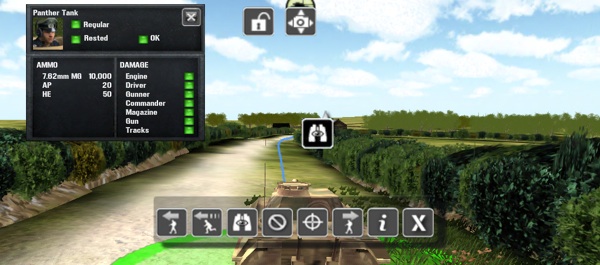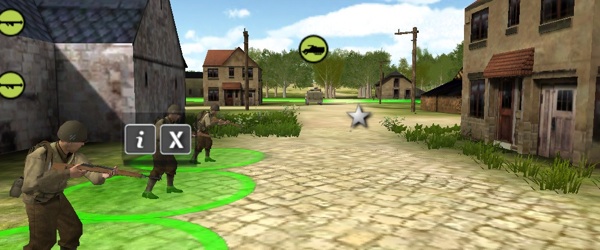Combat Mission Touch – iPad Game Review
 Combat Mission: Touch. iPad Game Review. Publisher/Developer: Battlefront. com $4.99 download.
Combat Mission: Touch. iPad Game Review. Publisher/Developer: Battlefront. com $4.99 download.
Passed Inspection: Great price; easy interface; fascinating play
Failed Basic: No editor; just seven scenarios included, which limits replay a bit
Game development for new paradigms seems to follow an established path. When games were first developed for Apple desktops in the early 1980s, they were essentially ports of boardgame systems presented electronically instead of on paper. Nothing is wrong with that; a good system is a good system regardless of platform. Publishers and developers are now moving popular PC games to tablets such as iPad. Battlefront’s decision to market their Combat Mission series to the iPad with Combat Mission: Touch is a welcome but risky gambit. The PC and Mac versions are very detailed with a devoted following. Departing too much from the original in order to accommodate the limited power of tablets could call down the wrath of the faithful.
{default}"Show ’em Your Combat Finger!"

Obviously, the biggest change from the PC version is the interface. Instead of click, drag and hotkeys, players have swipe, pinch, spread and twist for camera controls. Commands are given through taps on the map for unit selection and destinations with taps on pop-up menus for move and targeting orders. An "Undo" feature is available on the destination menu before confirmation of the order. Version 1.1 increased the user friendliness of these controls. For precise destinations and targeting, players may want to use a stylus.
Graphics are as good—if not better for some structures—than the PC version. Men and vehicles are modeled in detail, although men don’t wiggle in real life when they’re not moving. Units are identified not only by icons but by "balloons" floating over them in direct view or on the edges of the screen when the view leaves the immediate area, allowing quick access instead of requiring players to move the map.

Movement and line of sight are marked with colors denoting types of movements and fire. Shots and explosions are dramatic. Sounds include the usual crashes, screams, bullet pings and officer orders. Engines roar and boots tramp. During the computing phase, quotes from famous generals and facts about events and equipment are shown superimposed on the screen. The combat phase has tracers and fire results. Stricken vehicles burst into flame while men fall, but little structural damage is shown. Map icons allow quick map movement, locking the view to a unit and showing both friendly and enemy unit "balloons."
Watch and Learn

Units represent rifle teams, bazooka and panzerschreck teams, light machine guns, anti-tank guns, forward observers, tanks and halftracks. German tanks present are Mark IVs, Panthers and Tigers, while the Americans have Shermans and Wolverines. Heavy machine guns, engineers and mortars are notably absent. Tapping the "i" in the orders menu displays a pop-up showing the unit’s status, equipment and ammunition.
The orders menu allows move, move fast, hunt, cancel and target commands for all units. Infantry can go prone, and armor can reverse. These orders can be queued via waypoints. Infantry can be transported by halftrack. Moving fast decreases spotting ability and accuracy, but hunt increases both of those attributes. The forward observer can call in artillery but has to wait a few turns for spotting rounds, then wait some more while the area is zeroed-in before fire-for-effect happens. These game mechanics are explained well in a hilarious ten-minute tutorial video.

Icon balloons at the edge of the screen, showing units outside the immediate viewing area, cut down on map-scrolling.
Turns represent 30 seconds and are usually divided into three phases: command, calculating and replay. Every scenario has an extra turn in the beginning for deployment, consisting of dragging units within a start area and giving commands. Armor must be on open ground or roads; infantry can be placed in structures and forests. After the enemy gives orders, the computer calculates the moves. Replay allows players to watch the action. A slider is used to freeze or reverse play and players can change views. Another command phase then starts. Scenario lengths are between 16 and 24 turns with an auto-save each turn.
The seven scenarios represent actions on D-Day and shortly thereafter. Players can choose to play either Americans or Germans or allow the computer to choose. Unit density is comfortably low with less than 10 units per side. Scenarios are won by dominating a spot marked by a star. Since each side begins away from the star, each side will have a chance to defend and attack in every battle. Victory levels are determined by the number of casualties lost and inflicted. Hence, a tank sitting on the star wins a minor victor even if all other friendly units are gone and enemies are elsewhere on the map.

Scenarios have low unit density, and stars mark your mission’s objectives. Just drag your troops into your desired starting positions; you can issue orders when setup is complete.
Winning tactics are definitely historical. Infantry stays in cover—or quickly gets to it—and sets up overlapping fire zones. German tanks remain at long range and pick off the American M4s. The more numerous Shermans maneuver for side shots. All infantry can close-assault vehicles, but German rifle teams all have Panzerfausts, making them especially dangerous. The AI is very good, especially with fog of war on. The AI never deploys or attacks the same way, so although the game only comes with seven scenarios, each scenario has good replay value. Multiplay is through a server, but not much activity is apparent. This feature is undocumented.
Purists may decry the lack of a campaign or the other options available in the PC version. Perhaps an editor would be possible but ten pounds of game can’t be crammed into a five-pound can. With Combat Mission: Touch the developers have distilled the essence of a fine system into a highly playable portable format. All game publishers should follow their example.
(Combat Mission: Touch requires iOS 5.0 or later—Ed.)
Armchair General Rating: 97%
About the Author
Jim Cobb has been playing board wargames since 1961 and computer wargames since 1982. He has been writing incessantly since 1993 to keep his mind off the drivel he dealt with as a bureaucrat. He has published in Wargamers Monthly, Computer Gaming World, Computer Games Magazine, Computer Games Online, CombatSim, Armchair General, Subsim, Strategyzone Online and Gamesquad.

